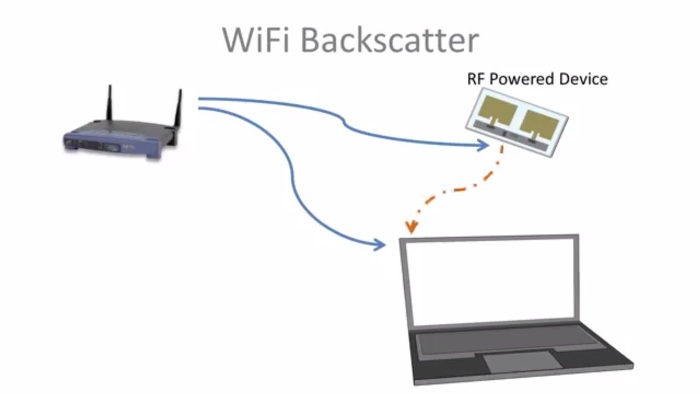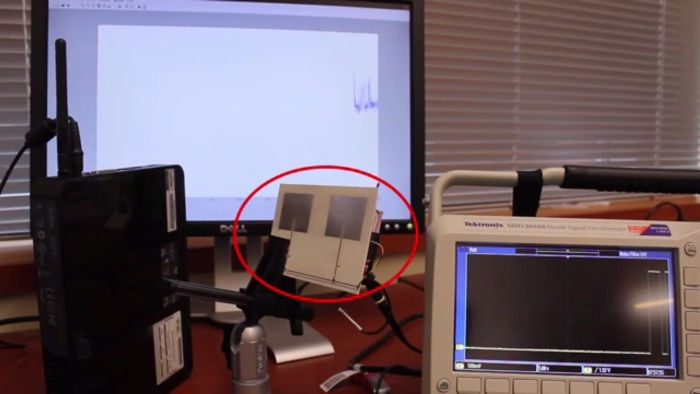Wi-Fi Backscatter: Battery-Free Connections for the Internet of Things

Screenshot of the Wi-Fi Backscatter technology video presentation (http://iotwifi.cs.washington.edu/)
Wireless connectivity technologies have greatly progressed over the years but the technologies responsible for powering the ubiquitous wireless devices in current use don’t appear to be keeping up. As wired data connection shifts to the more convenient wireless systems, power supplies remain mostly wired. There have been wireless power supply systems made commercially available but they still require contact or very close proximity. The promising wireless charging technologies are still under development and would probably require a few more years to become commercially available.
The shift to wireless power supply may not happen so soon but researchers from the University of Washington have developed an innovative solution to enabling connectivity among the Internet of Things without relying so much on batteries. This group of researchers with computer science and engineering backgrounds are expected to present a paper this month on a technology referred to as Wi-Fi Backscatter. The research team is composed by students Bryce Kellogg and Aaron Parks and faculty members Shyam Gollakota, Joshua Smith, and David Wetherall.
Wi-Fi Backscatter
Wi-Fi Backscatter is a new communication system that converts radio frequency signals into power without necessitating a dedicated gateway for data connection. It is a system that bridges RF-powered devices with the Internet, allowing these devices to make use of existing Wi-Fi infrastructure for Internet connection to RF-powered devices. The research team created a hardware prototype to demonstrate the viability of this novel technology, specifically its ability to support the communication link between an RF-powered device and commodity Wi-Fi devices.
To emphasize, Wi-Fi Backscatter is not a technology that takes away the need for batteries in wireless devices. Instead, it only reduces the amount of power necessary to establish Internet connection. It does not wirelessly charge smartphones, tablets, and other wireless devices using Wi-Fi signals. However, the concept has the potential to take away the need for batteries in small wireless sensors, repeaters, or some access points that use very minimal amounts of power.

Screenshot of the Wi-Fi Backscatter technology video presentation (http://iotwifi.cs.washington.edu/)
According to Bryce Kellogg, a doctoral electrical engineering student and one of the authors of the Wi-Fi Backscatter paper, the technology has the potential to be a “very big deal.” He says Wi-Fi Backscatter could “greatly reduce dependence on batteries and maybe even get rid of them and harvest energy for many devices.”
The prototype shown by the University of Washington researchers is an ultra-low power tag with an antenna and circuitry that can be connected to various electronic devices with Wi-Fi capability. This tag can communicate with laptops, smartphones, tablets, MP3 players, and other similar devices while using very minimal power.
How It Works
As mentioned, making use of the Wi-Fi backscatter system means using a tag that is similar to RFID tags. The tag does not require an internal power source to become functional. It generates its own power (around 10 microwatts or around 1/1000 to 1/100 of the power consumption of typical Wi-Fi modules) by harvesting ambient Wi-Fi signals. The tag then transmits data over short distances. At approximately seven feet, the tag can send data at a speed of 1 kbps. Indeed, this is a very slow speed when compared to the current speeds most people are now enjoying with their home Wi-Fi routers. However, the advantage of not requiring any battery or maintenance is an advantage that is difficult to ignore. This data speed is most likely sufficient to support the connectivity needs of most Internet of Things devices such as smart thermostats and smart lighting switches.
Data transmission is achieved as the tag monitors Wi-Fi signals moving between routers and wireless devices. The tag encodes data by either reflecting or not reflecting the Wi-Fi signals, creating slight changes in the wireless signal. Wireless devices (smartphones, tablets, computers, smart devices, etc) then detect these slight changes and receive data from the tag.
Again, this technology does not replace current Wi-Fi technology but works in conjunction with it. It needs Wi-Fi signals to power up and to enable connections. It only serves as a wireless bridge for devices to bring them to the Internet of Things. Also, for now it is mostly intended for controls or activation systems since the relatively very slow data transmission speeds cannot be used to take the place of typical data connections required by smartphones, tablets, Wi-Fi cameras, laptops, and smart watches.

Screenshot of the Wi-Fi Backscatter technology video presentation (http://iotwifi.cs.washington.edu/)
Outlook
The researchers have already applied for patents for this technology. They are also planning to start a company to be able to commercialize the Wi-Fi Backscatter tech. They intend to eventually extend the usable range of the Wi-Fi Backscatter tag to 20 meters and come up with tags that will work with more devices and have more convenient dimensions. For now, the tag’s size is still quite big and is considered by the researchers as the major drawback.